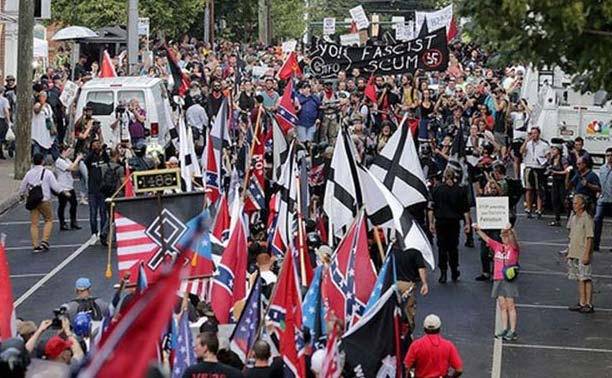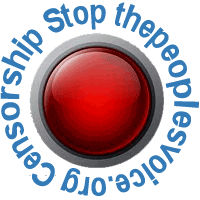| « Fascism: Empire’s Final Gasp 2025 | The Hidden War on Free Speech: How Fusion Centers and Military Surveillance Target Civilians and Creatives » |
The Warning That Was Charlottesville
By David Swanson
I recommend reading Charlottesville: An American Story by Deborah Baker. Itʼs an account, of course, not of all aspects of the city of Charlottesville, but principally of the Nazi-KKK-White Supremacist riot of 2017 that has taken on the name “Charlottesville” — including in a movie. The book itself is the furthest thing from predictable. The majority of it is pre-riot, with countless illuminating tangents and background stories and characters. In fact, that initial majority of the book is probably of greater interest than the blow-by-blow that follows or the very few words at the end about the eight years since.
Most surprising to me — apart from how much I could still learn about the place I live — is Bakerʼs blend of serious, credible reporting with a clear point of view on all sorts of controversial points. She is also refreshingly hard on so many people who I think deserve it, that I really donʼt mind how hard she is on me in a brief passage where I go unnamed, even though, naturally, I donʼt think I deserve it. More on that in a second.
But the overarching narrative should be of widespread concern. As Trump sends the Marines into Los Angeles to support the practice of disappearing certain types of people (and as the main objection is that the militaryʼs proper role is to kill and destroy elsewhere) it matters where Charlottesville-the-event came from, to what extent it was a product of the police as well as the civilian racists, and what was wise or unwise or still hard to judge in the variety of responses leading up to, during, and after August 12, 2017. Charlottesville-the-event has not been repeated exactly, though the attack on the U.S. Capitol had a lot of parallels, and yet it was part of strengthening something that is continuing to grow.
One thing that matters is whether we learn to be bolder or to hide. In March 2024, a City Council Member in Charlottesville said in a City Council meeting that it would be better not to oppose genocide in Gaza because doing that might make Charlottesville a target as in 2017. That City Council Member, by April, had learned a different lesson and changed his mind.
One of the warnings from Charlottesville, as from the U.S. Capitol, is that there were plenty of giant flashing neon warnings that were disregarded due to biases. Not everyone comes out of Charlottesville: An American Story looking badly. Emily Gorcenski is something of a central hero. Rev. Osagyefo Sekou looks as smart and strategic as he did back in our days with Kucinich for President (if that sounds stupidly quixotic, youʼve dated yourself as much as I have!). There were people who were well prepared and warning others.
Baker asks what the University of Virginia might have done with the warnings it received prior to the scheduled rally and prior to the torch-lit march through campus. She writes that the law school could have offered crash courses in civil disobedience and opened a bail fund, the hospital might have donated medical supplies and crash courses in first-aid, and the university could have at least sent an alert to everyoneʼs phone. That goes, I think, for the City of Charlottesville as well. It could have banned weapons, or at least non-gun weapons (donʼt ask, this is Virginia — which has since changed a little). It could have refused a permit. The ACLU could have distinguished armed threats from free speech and not defended the former. And the city could have offered free public courses in unarmed civilian defense. It could also have abolished and banned police, or instructed police to try to protect even people who were not themselves police. Baker notes at the end of her book that the President of UVa had defended the right of Nazis to free speech and assembly, despite their credible and honest threat of armed violence, but nonviolent students protesting on the UVa campus against a genocide in Palestine were attacked last year by militarized police troops.
I disagree with oversimplification more than I disagree with anyone on Charlottesville or most topics. So I appreciate all the perspectives and complexity included in Bakerʼs book. If Trump saying “there were very good people on both sides” means that supporting and opposing racist violence are morally equal, then of course itʼs absurd and disgusting. But if denouncing Trumpʼs comment means that the people on the racist violence side that day were born and will die irredeemably evil, impossible to ever talk to about anything, understanding — like a designated military target — only violence, then . . . well . . . I also find that absurd and disgusting.
Where I come into this book is as — if it were a play with characters — something like: Quirky Oblivious White Man Number 18. Of course, everyone calls me a white man, and I call myself a man, and I have been known to be both quirky and oblivious. In the book I go unnamed, but recognize myself as the jerk who stood up at a meeting about the statues in Charlottesville and proposed that Charlottesville erect a peace pole. Baker notes that I and other white people who spoke were “comfortable” with our proposed new creations sharing a park with a Confederate general, and that we had “clearly given the subject little thought,” and that we were driven by panic over the possibility that the statues might be moved, as opposed to added to. This is all fantasy. In 8 years, Baker has managed not to check it out at all.
Hereʼs my old petition for a peace pole which reads (and read at that time): “Charlottesville’s monuments to wars, including the Native American genocide, the defense of slavery, and the slaughter of 3.8 million Vietnamese, dominate public space. Removing them would be ideal.” I wanted ALL the statues gone, the racist war monuments and the supposedly non-racist war monuments. I had thought and written volumes on the subject. In 2018 I gave a TED Talk in Charlottesville on the subject. I never hid what I would or would not be “comfortable” with. I didnʼt come with a package of fragile, misguided beliefs discernable via the color of my face. Hereʼs what I wrote about the Racist Rally just prior to it. And here is what I wrote about it just after it. I can recognize loads of shortcomings in those blog posts. But I cannot recognize the schmuck who made it into Deborah Bakerʼs book.
Baker omits from her book and its references to Virginian bans on removing monuments or memorials, that the law (recently changed) was about monuments or memorials to war veterans or wars. You could always, always, always tear down a monument to peace or civil rights or athletics or arts or suffragettes or labor unions or anything that wasnʼt war. We never had any of those to tear down, but in theory you could have. My preference was, is, and remains taking down all the awful monuments to things we oppose, removing them from the centers of our towns, and sticking them in museums with explanations of where they came from and why they shouldnʼt have ever existed. Iʼve always opposed melting artworks down. Maybe I hate them insufficiently or am too good at resisting vengeful feelings (Iʼm not always) or — almost certainly — some combination thereof. But I also want more museums, more history, and more teaching. The U.S. expects countries like Germany to have museums about its sins, never the United States itself. People canʼt picture racist monuments being sent to U.S. museums about the horrors of racism, because there are not enough of such museums in existence.
Iʼve also always wanted and still want — and we still donʼt have — monuments in all our central spaces to things we can actually be proud of.
Some items of possible related interest from my website:
2018: Charlottesville Still Has Statues, Still Won’t Ban Guns
2018: Talk Nation Radio: Hawes Spencer on Charlottesville’s Summer of Hate
2018: #Charlottesville Is For Lovers
2018: Charlottesville As Cartoon
2019: Talk Nation Radio: Wes Bellamy on Charlottesville, Racism, and the Statue
2019: The Worst Statue in Charlottesville
2019: Charlottesville Divests from Weapons and Fossil Fuels
2019: New Report: Worst Monument in Charlottesville Can Be Removed
2019: Smedley Butler’s Speech Against War in Charlottesville in 1937
2020: Charlottesville Va. Bans Militarized Policing — Your City Can Too
2020: Now That Charlottesville Can Remove Monuments, Should It?
2023: The Violence Problem as Seen from Charlottesville
-###-
The Warning That Was Charlottesville
https://davidswanson.org/the-warning-that-was-charlottesville/
David Swanson is an author, activist, journalist, and radio host. He is executive director of WorldBeyondWar.org and campaign coordinator for RootsAction.org. Swanson's books include War Is A Lie. He blogs at DavidSwanson.org. He hosts Talk World Radio.




